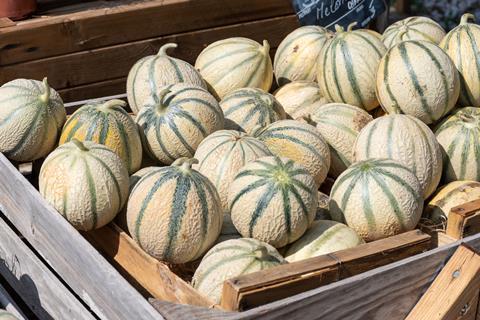Land, water and cost pressures are reducing the planted area of Charentais melons in Spain, but France and Morocco have seen a slight increase

Charentais melon plantings are on the up in Morocco and France but have slid considerably in Spain, as growers grapple with climate challenges and limited water supply.
Spain has seen its Charentais melon plantings fall by 40 per cent in the last three years amid mounting production costs and drought-related production challenges.
French organisation the Interprofessional Melon Association (AIM) revealed the plantings forecast at the Medfel trade show in Perpignan on 25 April.
It said weather conditions in Spain’s main melon production regions had been positive, causing the season to begin one week earlier than expected.
A good spread of production is forecast. But production costs have risen significantly, and plantings have fallen as a result.
Spain
Spain is set to produce 2,750 hectares of Charentais, 380ha less than in 2023. The main Spanish production region is around Murcia and Alicante, which has planted 2,000ha – a reduction of 200ha compared to last year.
Murcia, in particular, has seen a sharp decline in production – down 50 per cent in the last four years due to strong pressure on land and water access.
However, weather conditions this year have been favourable except for some wet weather during the week of Easter, which disrupted flowering.
Myriam Martineau of French producer Boule d’Or said there is “a worrying downward trend” for the Murcia-Alicante region, and said the melon sector in both Spain and Morocco was “at a turning point”.
According to AIM, the decline in Spanish production is down to several factors, including strong pressure on land, access to water, stricter environmental standards, especially in coastal areas, and sharply rising production costs.
France
In France, meanwhile, Charentais production has remained stable and is expected to increase slightly to 10,650ha (+150ha).
The biggest expansion in plantings is in the southeast of the country, which is set to grow 200ha more Charentais melons this season.
In the central western part of France, by contrast, there has been a 50ha reduction to 2,650ha. Approximately 7.5 per cent of France’s total Charentais production is organic.
Plantings proved complicated in March due to weather conditions but since April they have gone as planned. The harvest is set to begin in heated greenhouses in May, and towards the end of the month in larger unheated greenhouses.
Polytunnel production begins in June, but the arrival of major volumes will depend on how weather conditions evolve in the coming weeks.
Of the three countries – France, Spain and Morocco – France has by far the largest production of Charentais melons, although it lags way behind Spain in overall melon production when all varieties are considered.
With the aim of boosting sales of Charentais in future, AIM is pushing for the variety’s name to be changed to ’Cotele’ – to avoid confusion from some French consumers who assume the variety has PDO status and should only be produced in the Charente region of France.
Morocco
Finally, in Morocco, AIM reported a slight increase in planted area, offset by a reduction in yield. Despite some phytosanitary problems, particularly with aphids, the association said marketing of the fruit is going well.
Harvesting began in March and around 80 per cent of the crop has already been picked.
Overall, plantings increased slightly, up by 90ha to approximately 1,450ha. This expansion was seen in the Marrakech region (+50ha) and in Dakhla (+40ha).




